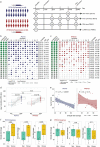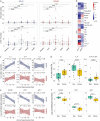This is a preprint.
Distinct baseline immune characteristics associated with responses to conjugated and unconjugated pneumococcal polysaccharide vaccines in older adults
- PMID: 37131707
- PMCID: PMC10153339
- DOI: 10.1101/2023.04.16.23288531
Distinct baseline immune characteristics associated with responses to conjugated and unconjugated pneumococcal polysaccharide vaccines in older adults
Update in
-
Distinct baseline immune characteristics associated with responses to conjugated and unconjugated pneumococcal polysaccharide vaccines in older adults.Nat Immunol. 2024 Feb;25(2):316-329. doi: 10.1038/s41590-023-01717-5. Epub 2024 Jan 5. Nat Immunol. 2024. PMID: 38182669 Free PMC article.
Abstract
Pneumococcal infections cause serious illness and death among older adults. A capsular polysaccharide vaccine PPSV23 (Pneumovax®) and a conjugated polysaccharide vaccine PCV13 (Prevnar®) are used to prevent these infections, yet underlying responses, and baseline predictors remain unknown. We recruited and vaccinated 39 older adults (>60 years) with PPSV23 or PCV13. Both vaccines induced strong antibody responses at day 28 and similar plasmablast transcriptional signatures at day 10, however, their baseline predictors were distinct. Analyses of baseline flow cytometry and RNA-seq data (bulk and single cell) revealed a novel baseline phenotype that is specifically associated with weaker PCV13 responses, characterized by i) increased expression of cytotoxicity-associated genes and increased CD16+ NK frequency; ii) increased Th17 and decreased Th1 cell frequency. Men were more likely to display this cytotoxic phenotype and mounted weaker responses to PCV13 than women. Baseline expression levels of a distinct gene set was predictive of PPSV23 responses. This first precision vaccinology study for pneumococcal vaccine responses of older adults uncovered novel and distinct baseline predictors that might transform vaccination strategies and initiate novel interventions.
Figures





References
-
- Novak R, Tuomanen E. Pathogenesis of pneumococcal pneumonia. Semin Respir Infect. 1999;14(3):209–17. Epub 1999/09/29. - PubMed
-
- Robinson KA, Baughman W, Rothrock G, Barrett NL, Pass M, Lexau C, Damaske B, Stefonek K, Barnes B, Patterson J, Zell ER, Schuchat A, Whitney CG, Active Bacterial Core Surveillance/Emerging Infections Program N. Epidemiology of invasive Streptococcus pneumoniae infections in the United States, 1995-1998: Opportunities for prevention in the conjugate vaccine era. JAMA. 2001;285(13):1729–35. Epub 2001/04/13. doi: 10.1001/jama.285.13.1729. - DOI - PubMed
Publication types
Grants and funding
LinkOut - more resources
Full Text Sources
Medical
Molecular Biology Databases
